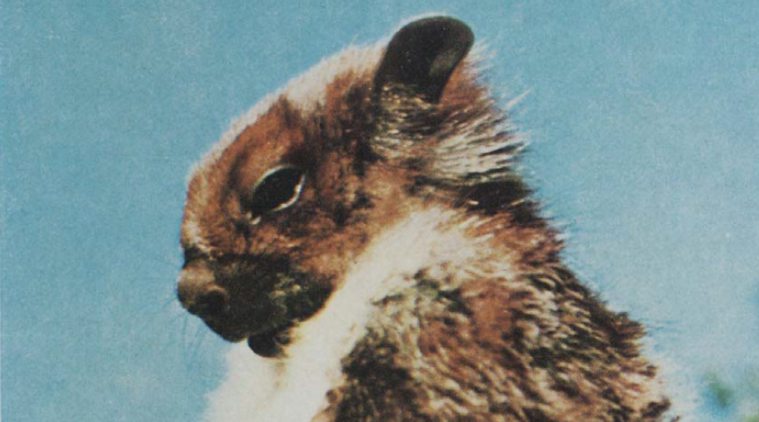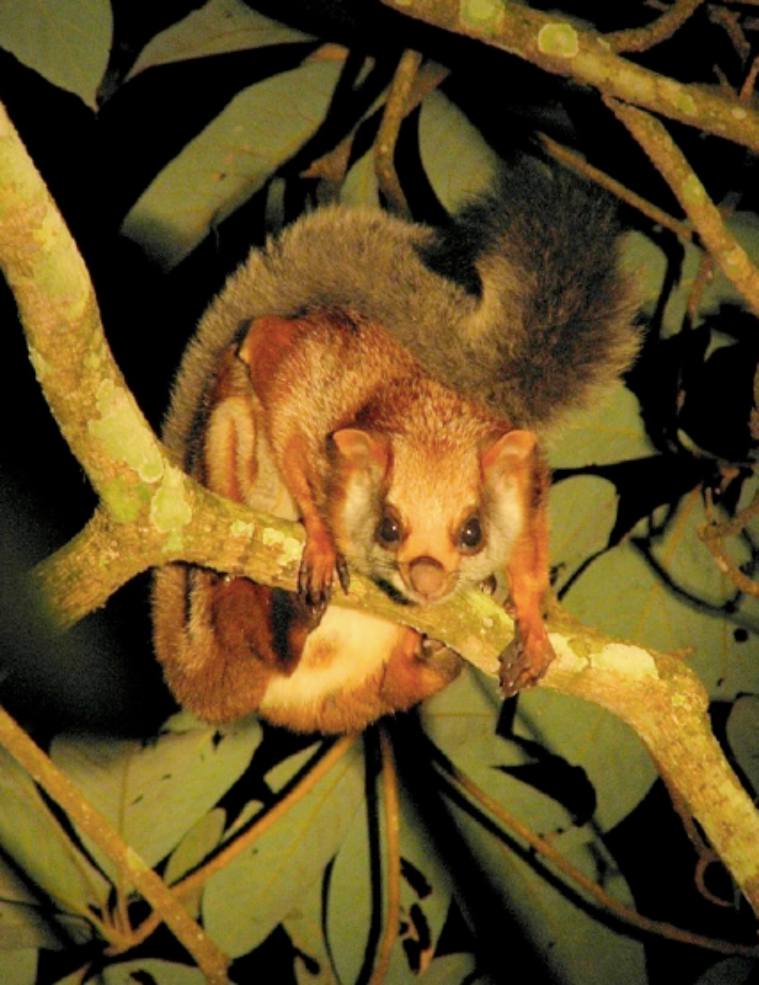- India
- International
In the forests of Arunachal Pradesh, the search for a missing squirrel
The only evidence of its existence is a single specimen that was collected in a remote corner of Arunachal Pradesh in 1981. Thirty eight years on, a group of wildlife scientists are on their first dedicated mission to find the “missing” flying squirrel of Namdapha.
 In 1981, Dr SS Saha was the first to sight the Namdapha Flying Squirrel. Seen here is a close-up of the rare squirrel published in a research paper by the Zoological Survey of India in 1981. Photo Courtesy: SS Saha (1981) | Zoological Survey of India
In 1981, Dr SS Saha was the first to sight the Namdapha Flying Squirrel. Seen here is a close-up of the rare squirrel published in a research paper by the Zoological Survey of India in 1981. Photo Courtesy: SS Saha (1981) | Zoological Survey of India
It was on a fragrant Nahor tree that a team from Zoological Survey of India (ZSI) first spotted the flying squirrel on a summer evening in 1981. “Beautifully coloured animal with gorgeous fur”: Dr Subhendu Sekhar Saha, the wildlife scientist part of the team, later described the discovery in a paper published by the ZSI.
On examination, the scientists realised that the specimen was unique: a flying squirrel belonging to a “hitherto undescribed genus.”
The species was named the Namdapha Flying Squirrel after the location it was discovered in: the Mesua ferra jungles bordering the Noa Dihing river in Arunachal Pradesh — an area which now falls under the Namdapha National Park, today the third-largest national park in India.
For its generic name, Dr Saha decided to call the squirrel the Biswamoyopterus biwasi, in honour of former joint director of ZSI, Dr Biswamoy Biswas — his mentor of twenty years.
The specimen is now preserved in the ZSI headquarters in Kolkata — the only evidence that the Namdapha Flying Squirrel exists. Since Dr Saha’s first expedition in 1981, the squirrel has not been sighted anywhere in the world.

Crowdfunding The Search
Apart from informal sighting by photographers — which are not scientifically backed — there hasn’t been a dedicated effort to look for the Namdapha squirrel.
“Creatures like these are not that ‘glamorous’ and get less attention This could be one of the reasons why it has not been rediscovered. And like pink-headed ducks, this squirrel is probably just very, very rare,” says Dr Murali Krishna, Assistant professor of the Amity Institute of Forestry & Wildlife, Amity University in Noida.
In October, Dr Murali will be part of the first-ever expedition to rediscover the Namdapha Flying Squirrel — an initiative organised by IUCN SSC Small Mammal Specialist Group (SMSG), Global Wildlife Conservation (GWC) and Guwahati-based conservation group Aaranyak.
Earlier this year in January, the groups organised a crowdfunding campaign asking people to donate towards the “search for India’s lost Namdapha Flying Squirrel”. In March, the campaign met its target and raised sufficient funds.
This will now enable a team of wildlife biologists to embark on a six-month rediscovery expedition, starting November.
If rediscovered, the scientists are confident of saving the species from extinction — not just the Namdapha Flying Squirrel, but other flying squirrel species which are found in the Northeast and face similar risks of extinction.
Why is the Namdapha Flying Squirrel so rare?
Very little research has been done on flying squirrels in general, let alone the Namdapha Flying Squirrel. Dr Murali, whose PhD is on flying squirrels of Arunachal Pradesh, says: “When I first began research, there was very little literature on the topic: a few papers from the South and Southeast Asian countries. I saw a lot of gaps in the research especially in these regions despite high diversity of flying squirrels here. But the western world — especially the US — has ample of literature available for the other flying squirrel species.”
 The specimen is now preserved in the ZSI headquarters in Kolkata — the only evidence that the Namdapha Flying Squirrel exists. Photo Courtesy: SS Saha (1981) | Zoological Survey of India
The specimen is now preserved in the ZSI headquarters in Kolkata — the only evidence that the Namdapha Flying Squirrel exists. Photo Courtesy: SS Saha (1981) | Zoological Survey of India
Dr Murali later spent six years (2011 to 2016) in the Northeast, mostly in Arunachal Pradesh, for his field work.
The highest diversity of flying squirrels in the world are found in South and Southeast Asia. “Most squirrels are huge. They weigh at least 2-2.5 kgs and can glide up to 100-200 metres,” says Dr Murali, “There are fourteen species of flying squirrels in Arunachal Pradesh alone: the diversity is equivalent to Thailand and almost to that of Malaysia!”
These include the Mebo Giant Gliding Squirrel, Bhutan Giant Gliding Squirrel, Grey Headed Gliding Squirrel, among others.
Then why has the Namdapha Flying Squirrel evaded rediscovery?
“There could be many reasons for it,” says Dr M Firoz Ahmed, Conservation Biologist with Aaranyak, “The squirrels are nocturnal and perhaps they are found only in certain areas of Namdapha where people might not necessarily venture into at night,” he says, “
This is what their expedition — led by Dr Ahmed and Dr Murali — is planning to target: areas that haven’t been studied before. For it, they will be using a variety of advanced techniques: arboreal camera bait stations, tree-hole scoping, and spot-lighting.
From Dr Saha’s 1981 discovery, the scientists are aware that the arboreal squirrel is active at dusk, and at elevations between 100 and 350m on nahor (Mesua ferrea) trees. “So, it is this habitat we will be targeting,” says Dr Ahmed.
Accompanying them will be a team of locals from Namdapha National Park.
A common mistake
Till 2012, the Miao Museum of Namdapha National Park displayed a specimen of the Namdapha Flying Squirrel.
“But it was actually the Red Giant Flying Squirrel — which is commonly mistaken to be the Namdapha Flying Squirrel,” says Dr Murali.
The core colour of both the animals are the same but the key distinguishing factor, he points out, is that the Namdapha Flying Squirrel has a white-coloured ear tuft, which is absent in the Red Giant Flying Squirrel.
“A closer examination would also reveal that the former is a little smaller than the latter,” says Dr Murali, who got the Miao Museum authorities to rectify the incorrect classification.
 A picture of the Red Giant Gliding Squirrel, commonly mistaken for the Namdapha Flying Squirrel. Photo Courtesy: Dr Murali Krishna
A picture of the Red Giant Gliding Squirrel, commonly mistaken for the Namdapha Flying Squirrel. Photo Courtesy: Dr Murali Krishna
Murali also says that these species actually glide (as opposed to fly). Thus, he now consciously tries referring to them as “gliding” squirrels.
While the animal’s evasiveness has led many to believe that it was wrongly identified in the first place, an incident in 2014 — when a team from the National University of Laos discovered the Laotian Giant Flying Squirrel in a bushmeat market in Laos PDR — changes things. “It was very similar to the Namdapha squirrel. Infact, the Laos squirrel was the second species to be found under the same genus,” says Dr Murali. This proves that Dr Saha’s 1981 expedition was not erroneous.
Dr Ahmed and Dr Murali’s expedition will begin in winter and carry on till about April 2020.
The chances? “Can’t say but optimistic,” says Dr Murali. What helps their case is that a large part of Namdapha National Park remains unexplored to date — reason enough to believe that the lost Namdapha Flying Squirrel is hiding somewhere in there.
Apr 19: Latest News
- 01
- 02
- 03
- 04
- 05






































